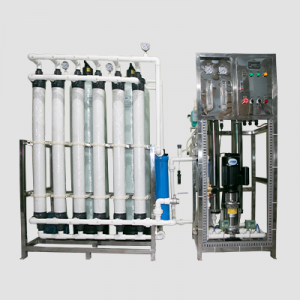A Reverse Osmosis (RO) water treatment plant is a system that uses a semi-permeable membrane to remove dissolved salts and impurities from water. The process typically includes several stages, including pre-treatment, membrane filtration, and post-treatment.
- Pre-treatment: In this stage, the water is filtered to remove large particles, such as sediment and debris, using a series of screens and filters. Additionally, chemical treatments may be used to remove dissolved impurities such as iron, manganese, and chlorine.
- Membrane filtration: The water is then sent to the RO system where it is pressurized to force it through a semi-permeable membrane. The membrane acts as a filter, allowing water molecules to pass through while trapping dissolved impurities and salts, such as sodium, calcium, and magnesium.
- Post-treatment: After passing through the membrane, the water may be disinfected and sterilized to remove any bacteria or viruses. The water may also be subjected to a de-chlorination process to remove any residual chlorine.
- Reject Water: The water that is filtered out by the membrane and contains a high concentration of dissolved impurities, is called reject water. Depending on the application, it could be discharged or further processed to reduce the dissolved impurities and make it suitable for different use.
- Final product : the treated water that has passed through the RO system is considered a high-quality, purified product that can be used for various applications, such as drinking water, industrial processes, and irrigation.
It is important to note that the specific process used in a RO plant can vary depending on the type of water being treated and the desired end product. Additionally, regular maintenance and monitoring of the system is crucial to ensure that the water is being treated effectively and that the membrane is in good condition.

contact us
Mobile/WhatsApp:
Email: toptechbd@yahoo.com
whooper xyandanxvurulmus.klPaigxJu0nA